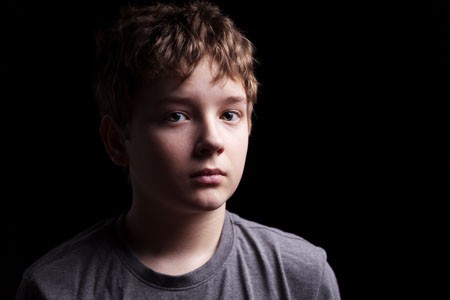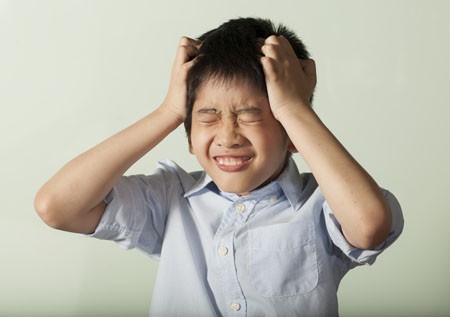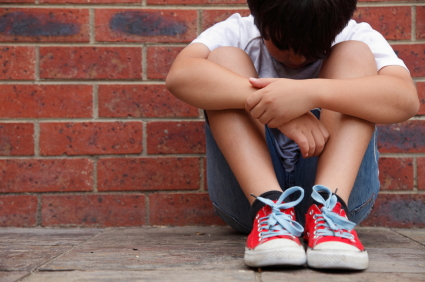Anxiety, Depression, Unstable Mood, and Low-Level Mania Best Predictors of Bipolar Disorder
Researchers are looking for better ways of predicting whether children at risk for bipolar disorder will go on to develop the illness. A 2015 study by David Axelson and colleagues in the American Journal of Psychiatry reported that in the offspring of parents with bipolar disorder, diagnoses of sub-threshold mania, depression, and disruptive behavior disorders were associated with subsequent diagnosis of full-blown Bipolar I or Bipolar II disorders six to seven years later.
More recently, in an article by Danella M. Hafeman and colleagues in the American Journal of Psychiatry, the same group of investigators has examined how symptoms (rather than categorical diagnoses, as in the earlier study) predict the development of bipolar disorder. In children and adolescents at high risk for bipolar disorder (because they have a parent with the disorder) three types of symptoms were the best predictors of later bipolar disorder: anxiety/depression at the time participants entered the study, unstable mood or irritability both when entering the study and shortly before a bipolar diagnosis, and low-level manic symptoms observed shortly before diagnosis.
The earlier the age at which a parent was diagnosed with a mood disorder, the greater the risk that the offspring would also be diagnosed with bipolar disorder. Youth with all four risk factors (anxiety or depression, mood changes, low-level mania, and a parent who was diagnosed with a mood disorder at an early age) had a 49 percent chance of developing bipolar disorder, compared to a 2 percent chance among those without those risk factors.
Childhood onset of bipolar disorder and long delays until first treatment for depression or mania are both significant predictors of a poor outcome in adulthood compared to adult onsets and shorter delays to treatment. Read more
Psychiatric Symptoms in Childhood Linked to Struggles in Adulthood
Psychiatric illness is one of the most common health problems among children. A study by William E. Copeland and colleagues in the journal JAMA Psychiatry indicates that psychiatric symptoms and diagnoses in childhood can lead to struggles with health, the legal system, personal finances, and social functioning in early adulthood, even if the psychiatric symptoms themselves do not last.
The study included 1420 participants from 11 mostly rural counties in North Carolina, who participated in structured interviews up to six times between the ages of 9 and 16 to determine the existence of psychiatric symptoms and diagnoses. Of these, 1273 were assessed three times during young adulthood, at the ages of 19, 21, and 24–26, for any evidence of social, legal, financial, or health problems.
Participants who had had a childhood psychiatric disorder were six times more likely to have at least one adverse outcome in adulthood compared to participants with no history of psychiatric problems, and nine times more likely to have two or more adverse outcomes in adulthood. Those participants who had psychiatric symptoms that were not sufficient for a particular diagnosis were still three times more likely to have at least one adverse outcome in adulthood, and five times more likely to have at least 2 adverse outcomes. The cumulative number of psychiatric disorders to which a participant was exposed was the best predictor of adverse outcomes in adulthood.
Even moderate psychiatric problems in childhood can disrupt a person’s transition to adulthood. However, early treatment and prevention can help reduce the long-term impact of psychiatric illness. Parents of children (aged 2–12) with mood and behavioral symptoms are welcome to join the Child Network, a system for collecting weekly ratings of their children’s symptoms and displaying them longitudinally for the child’s doctor.
Recovery and Relapse After a First Mania
The timeframe during which recovery and recurrence occur in people with a first episode of mania are somewhat variable. A meta-analysis by Andréanne Gignac and colleagues published in the Journal of Clinical Psychiatry in 2015 offers some new information. The meta-analysis included eight studies with a total of 734 participants in a first episode of mania. Syndromal recovery rates (when patients no longer met diagnostic criteria for bipolar disorder) were 77.4% at six months after first episode of mania and 84.2% at one year after. However, some symptoms lingered, and only 62.1% of patients reached a period of symptomatic recovery within one year.
Recurrence rates were 25.7% within six months, 41.0% within one year, and 59.7% by four years. Those who were younger at the time of the first episode were at higher risk for relapse within one year.
Editor’s Note: On the positive side, most recovered, but on the negative side, at one year, 60% remained symptomatic and 40% had a recurrence. What is not clear is how intensively patients were treated and monitored. The main message of this study is that a first episode of mania is not trivial and deservces concerted acute and long-term treatment. When expert multimodal treatment is given results are vastly more superior than treatment as usual (Kessing et al. British Journal of Psychiatry 2013).
Loss of Appetite or Weight in Depressed Parents Predicts Depression in Children
 Depression in a parent is one of the factors that best predicts whether a young person will develop depression. Since depression symptoms can vary greatly from person to person and some symptoms are known to be more heritable than others, new research is investigating whether a parent’s profile of symptoms affects their child’s likelihood of developing the illness. A 2013 study by Mars et al. in the Journal of Clinical Psychiatry suggests that loss of appetite or weight in a parent with depression is the symptom that most strongly predicts new onset of depression and depressive symptoms in their offspring.
Depression in a parent is one of the factors that best predicts whether a young person will develop depression. Since depression symptoms can vary greatly from person to person and some symptoms are known to be more heritable than others, new research is investigating whether a parent’s profile of symptoms affects their child’s likelihood of developing the illness. A 2013 study by Mars et al. in the Journal of Clinical Psychiatry suggests that loss of appetite or weight in a parent with depression is the symptom that most strongly predicts new onset of depression and depressive symptoms in their offspring.
The study observed 337 parent-child pairs. The parents (mostly mothers), who had a history of recurrent unipolar depression, ranged in age from 25–55 years, and their children ranged from 9–17 years. The study lasted four years, during which the families participated in three assessments. Parents’ symptoms were recorded and children were also assessed for symptoms or new development of depression. Thirty percent of the offspring whose parents reported weight loss or low appetite were found to have new onset of depression at followup, compared to nine percent of the offspring whose parents did not have these symptoms.
There are nine symptoms used to diagnose depression in the Diagnostic and Statistical Manual for Mental Disorders: low mood, loss of interest (anhedonia), loss of energy, change in appetite or weight, change in sleep, low self-esteem or guilt, suicidality, psychomotor slowing (retardation), and loss of concentration or indecisiveness. Of these, parental loss of appetite or weight was the only symptom that predicted depression in a child. Interestingly, the severity of parental depression or the presence of other health problems in the parent did not account for the emergence of illness in the children.
Long Delays to First Treatment Are Crippling Many with Bipolar Disorder: What You Can Do
An article published by N. Drancourt et al. in the journal Acta Psychiatra Scandinavica this year examined the duration of the period between a first mood episode and treatment with a mood stabilizer among 501 patients with bipolar disorder. The time between a first episode of depression, mania, or hypomania and first treatment averaged 9.7 years. The authors conclude that more screening, better recognition of the early stages of the illness, and greater awareness are needed to decrease this long delay.
Editor’s Note: The article by Dancourt et al. replicates earlier findings of an average treatment delay of 10 years among bipolar patients from the treatment network in which this editor (Robert Post) is an investigator (formerly the Stanley Foundation Bipolar Network, now called the Bipolar Collaborative Network). The duration of the untreated interval (DUP) for patients with bipolar disorder is unacceptably long and carries a heavy price.
Those with the earliest age of onset experience the longest delay to first treatment. Early onset is associated with poor outcome compared to adult onset bipolar disorder, and the duration of time untreated adds a separate, independent risk of a worse outcome in adulthood, especially more frequent and severe depression, more episodes, and less time well.
What patients and doctors can do to shorten this interval to first treatment: Know the risk factors for early onset bipolar disorder so you can seek evaluation and advise treatment as appropriate. Read more





